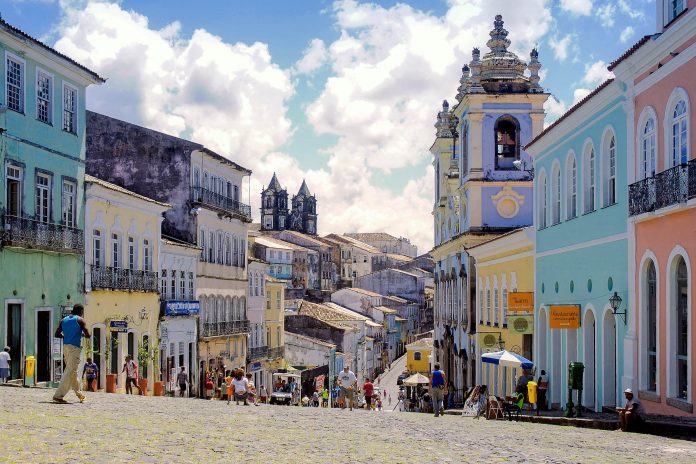Das sehenswerte Viertel Pelourinho ist Teil der brasilianischen Stadt Salvador und befindet sich in der so genannten Oberstadt. Der ehemalige Sklavenmarkt hat sich zum angesehenen Viertel und kulturellen Zentrum Salvadors entwickelt.
Pelourinho ist ein Teil der Oberstadt (Cidade Alta) und begeistert mit seiner wunderschönen Kolonialarchitektur und den prachtvollen Barockkirchen zahlreiche Besucher. 1985 wurde Pelourinho auf die Liste des UNESCO-Weltkulturerbes aufgenommen. Das malerische Stadtviertel zählt auch zu unseren Top 10 Sehenswürdigkeiten von Brasilien und Salvador da Bahia.
Inhaltsverzeichnis
BILDER: Pelourinho in Salvador da Bahia
Fotogalerie: Pelourinho in Salvador da Bahia
Geschichte von Pelourinho
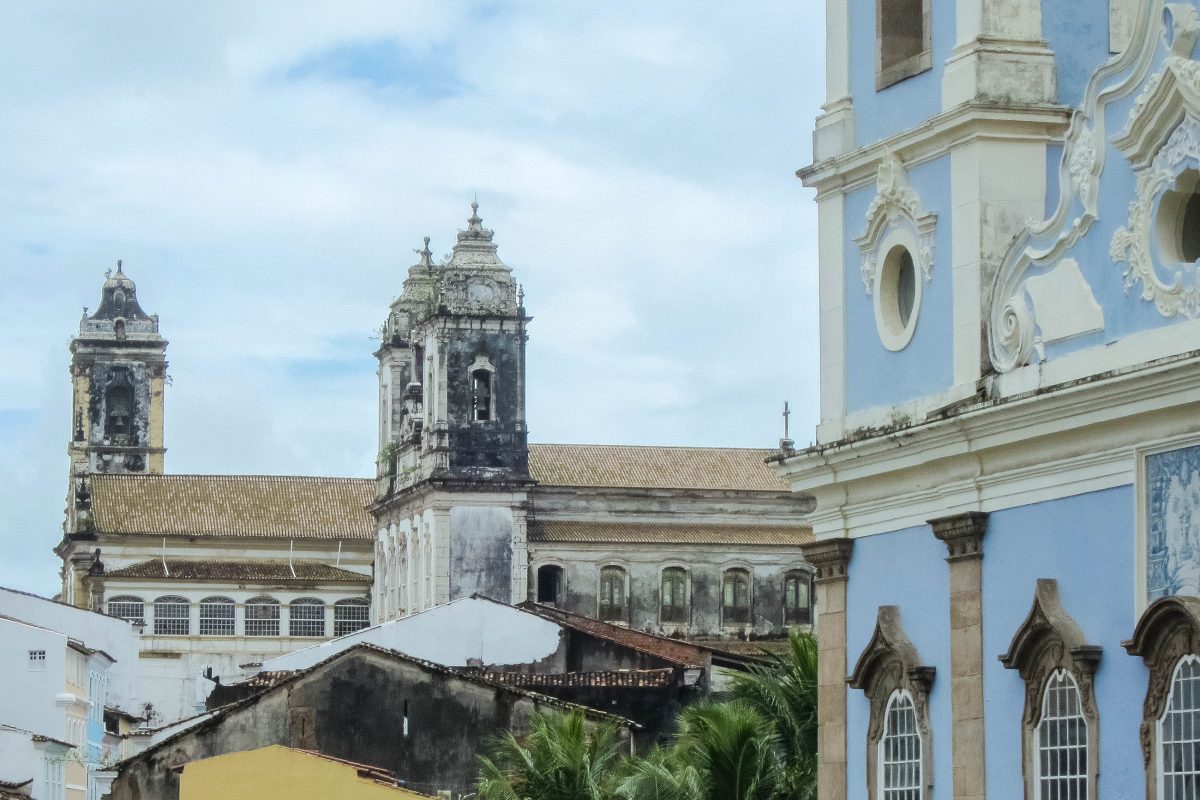
Das portugiesische „Pelourinho“ bedeutet übersetzt „Pranger“, dieser Name stammt noch aus der Zeit des Sklavenhandels. Im 17. Jahrhundert war Salvador ein bedeutender Umschlagplatz für aus Afrika verschleppte Sklaven. Der heutige Pelourinho fungierte als Sklavenmarkt, auf dem um Menschenleben gefeilscht wurde.
Als 1888 die Sklaverei verboten wurde, ließen sich nach und nach Künstler aller Sparten am Pelourinho nieder. Musiker, Filmemacher, Maler und Schriftsteller machen den ehemaligen Sklavenmarkt zu einem mittlerweile angesehenen Viertel und kulturellen Zentrum Salvadors.
Doch in den 1930er-Jahren wanderten die Familien aus der Ober- und Mittelschicht aus Pelourinho ab und ließen sich an den traumhaften Stränden um Salvador nieder. Das von den Einheimischen liebevoll „Pelô“ genannte Viertel begann langsam zu verfallen und die prächtigen Herrenhäuser wurden in Mietskasernen für weniger betuchte Bewohner umgewandelt.
Mit der Armut der hauptsächlich schwarzen Familien hielten auch Kriminalität und Drogenhandel in Pelourinho Einzug. Das damals unsicherste Viertel von Salvador konnte von Touristen nur tagsüber besucht werden.
„Rettung“ durch die UNESCO

Mit der Ernennung von Pelourinho zum Weltkulturerbe wandelte sich jedoch sein Schicksal. Anfang der 1990er-Jahre wurden fast 800 Bauten mit großem finanziellen Aufwand renoviert. Aus den Mietskasernen wurden wieder Galerien, Restaurants und Shops und seit 2005 dürfen auch keine Autos mehr nach Pelourinho. Die Kriminalität wurde eingedämmt und die Bewohner Salvadors sind wieder stolz auf ihr buntes Viertel.
Tipp: Aufgrund der hohen touristischen Beliebtheit Pelourinhos ist die Anzahl von Taschendieben nach wie vor hoch.
Sehenswürdigkeiten von Pelourinho
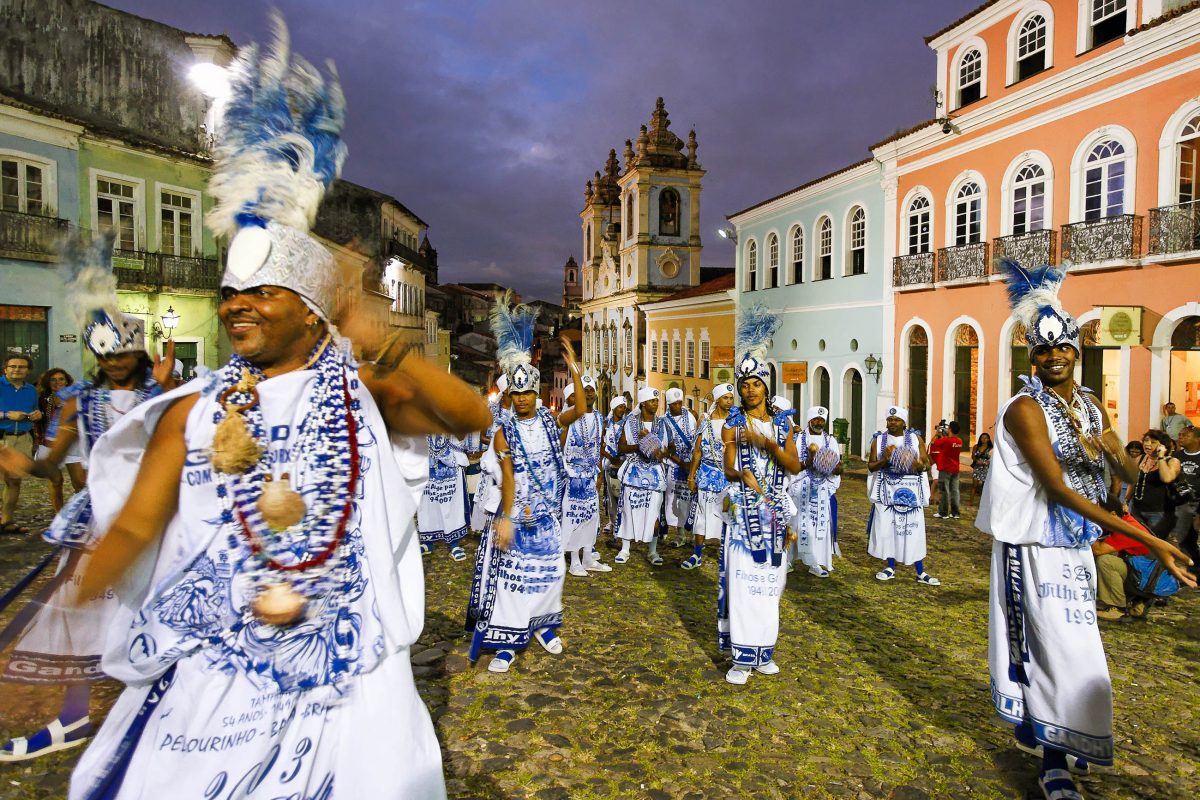
Heute verzaubert Salvadors Altstadt seine Besucher mit einem speziellen Flair. Ein Großteil der Bevölkerung sind Nachkommen der ehemaligen Sklaven, deren afrikanische Religion und Kultur trifft man hier überall. Der barocke Baustil ist in Pelourinho unübersehbar und wird seit 1990 mit Hilfe der UNESCO restauriert und erhalten.
Beim Spaziergang durch die engen gepflasterten Gassen zwischen den bunten pastellfarbigen Fassaden der Häuser stellt man sofort fest, dass sich das Leben im wahrsten Sinne des Wortes auf der Straße abspielt. Restaurants und Cafes sind meist überfüllt.
Die Bewohner Salvadors spielen Karten in den Gassen und treffen sich in Gruppen zum täglichen Tratsch. Capoeira-Tanzgruppen trifft man an allen Ecken und Enden. Wer auf der Suche nach einem passenden farbenfrohen Bild für sein Eigenheim ist, wird hier am Künstlermarkt bestimmt fündig.
Largo da Pelourinho

Der bedeutendste Platz in Pelourinho ist der abschüssige, kopfsteingepflasterte Largo da Pelourinho. Hier stand früher der Pranger für die straffälligen Sklaven, der dem Viertel seinen Namen gab. Heute ist sein Panorama mit den restaurierten Kolonialgebäuden absolut einzigartig.
Sofort ins Auge fallen die zwei blaugetünchten Türme der prächtigen Rokoko-Kirche Igreja Nossa Senhora do Rosário dos Pretos. Sie wurde Anfang des 17. Jahrhunderts von freigelassenen Sklaven und Schwarzafrikanern erbaut, da sie die Kirchen der Weißen nicht betreten durften.
Ebenfalls am Largo da Pelourinho befinden sich das Museu da Cidade mit wechselnden Ausstellungen zu afrobrasilianischer Kunst und das Museu das Portas do Carmo, in dem Fahnen und Waffen aus der Epoche der holländischen Besatzung besichtigt werden können.
Tipp: Im Restaurante Escolar am Largo Pelourinho Nr. 13 gleich neben der Igreja Nossa Senhora do Rosário dos Pretos kann man besonders günstig essen. Hier werden Gastronomie-Schüler ausgebildet, die ausgezeichnete Menüs zu sensationellen Preisen zaubern.
Stadtviertel Carmo
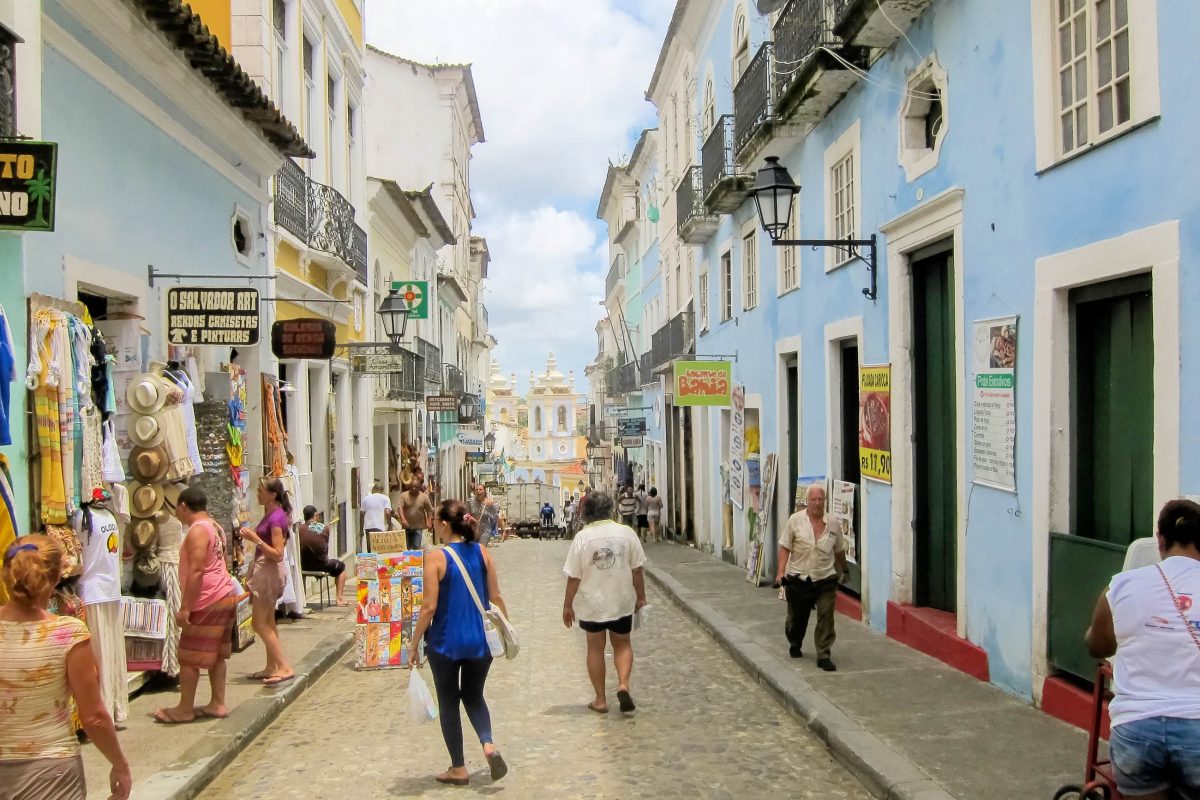
Folgt man dem Largo da Pelourinho weiter Richtung Nordosten erreicht man über die steile Ladeira do Carmo das ruhige Stadtviertel Carmo, in dem weitere Kirchen und Museen auf den interessierten Besucher warten.
Terreiro de Jesus
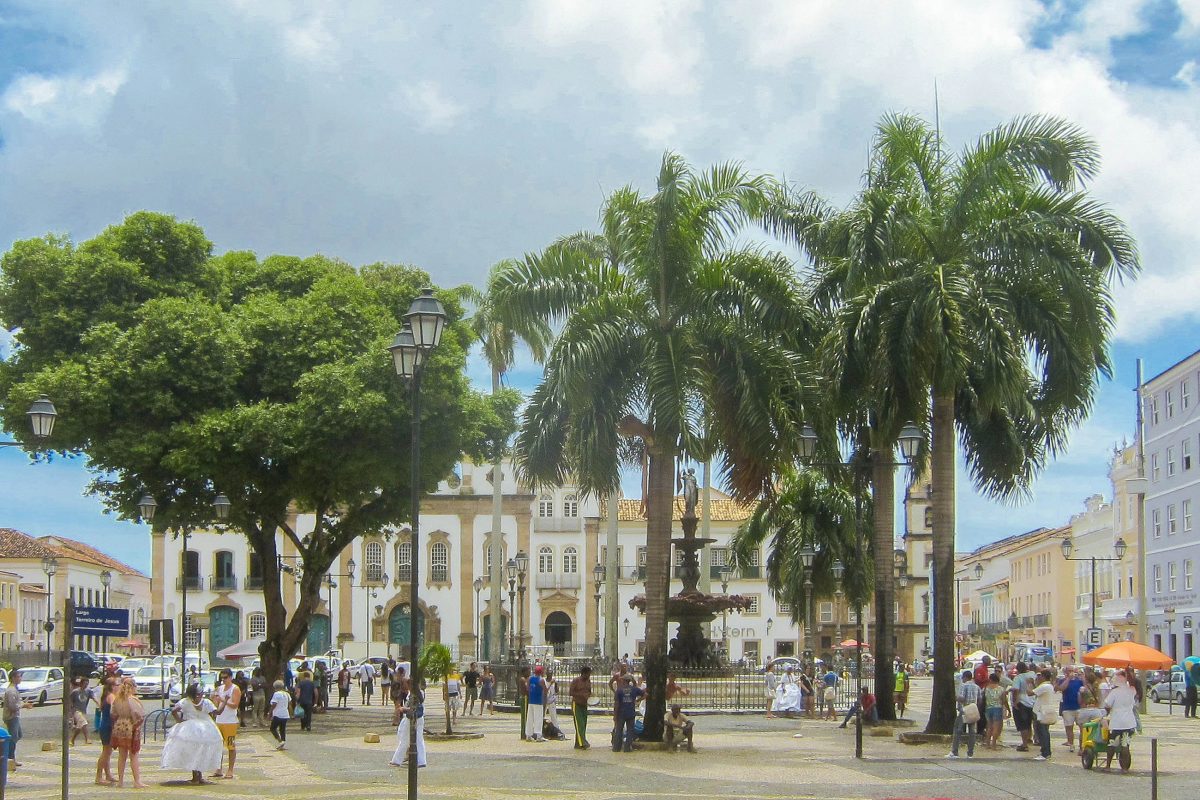
Am anderen Ende, im Südwesten von Pelourinho liegt der palmenbewachsene Terreiro de Jesus. Um den Springbrunnen in der Mitte gruppieren sich mehrere Prachtbauten, darunter die opulent geschmückte Kathedrale von Salvador da Bahia und das Museu Afrobrasileiro, welches Kunst, Kleidung, Schmuck und Musikinstrumente präsentiert.
Igreja de São Francesco

Die monumentale Barockkirche Igreja de São Francesco beeindruckt bereits durch ihre reich verzierte Fassade. Ihre ganze Pracht zeigt sie jedoch erst im Inneren, denn das gesamte Kirchenschiff ist mit einer schier unfassbaren Menge an Blattgold überzogen – ein wahrhaft strahlender Anblick.
Largo de Teresa Batista
Ziemlich genau zwischen dem Terreiro de Jesus und der Igreja de São Francesco an der Rua Barreto liegt der Largo de Teresa Batista. Der Platz hat neben Kneipen und Restaurants ein ganz besonders Gustostückchen zu bieten.
Hier probt immer wieder die berühmte Rhythmusgruppe Olodum, die bereits gemeinsam mit renommierten Künstlern wie Michael Jackson, Herbie Hancock oder Jimmy Cliff aufgetreten sind. Im Musikvideo „They don’t really care about us“ von Michael Jackson sind die weltbekannten Trommler vor der Kulisse der Favela Santa Marta in Rio de Janeiro und des Pelourinhos zu sehen.
Weiterführende Links:
Offizielle Website von Pelourinho
Offizielle Website der Rhythmusgruppe Olodum

